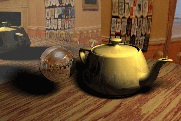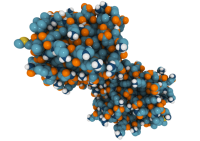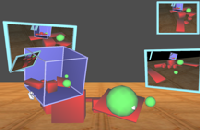Semantics modeling of graphical data
My earlier research in the Laboratory of Dialogue Systems, LSD, at the Faculty of Informatics, Masaryk University. In this research group, we aimed at developing techniques and applications enabling visually impaired people to explore pictures by means of natural language. Our approach was based on ontology-based semantic modeling of graphical data, automated picture annotation, and smart dialogue interaction.
Software:

The GATE system (Graphics Accessible To Everyone) was designed and developed to help visually impaired people to explore pictures by the dialogue in natural language. The key concept lies in well-structured annotations backed by formal ontologies that enable us to generate dialogues strategies automatically from the picture content.
Related projects:
2007 – 2010
Dialogue generation of web presentations and graphics for visually impaired people
My role: Member of the research team, the key researcher responsible for software architecture and semantic modeling.
1999 – 2004
Human-computer interaction, dialog systems and assistive technologies
My role: Member of the research team.
Selected publications:
- KOPEČEK, Ivan and Radek OŠLEJŠEK. Annotating and Describing Pictures — Applications in E-learning and Accessibility of Graphics. In Computers Helping People with Special Needs: 12th International Conference, ICCHP 2010. Berlin: Springer-Verlag, 2010. p. 124-130, 7 pp.
- KOPEČEK, Ivan and Radek OŠLEJŠEK. Dialogue-Based Processing of Graphics and Graphical Ontologies. In Text, Speech and Dialogue. Proceedings of 11th International Conference. Berlin: Springer, 2008. p. 601-608, 8 pp.
- KOPEČEK, Ivan and Radek OŠLEJŠEK. Hybrid Approach to Sonification of Color Images. In The 2008 International Conference on Convergence and Hybrid Information Technology. Los Alamitos: IEEE Computer Society, 2008. p. 722-727, 6 pp.
- KOPEČEK, Ivan and Radek OŠLEJŠEK. GATE to Accessibility of Computer Graphics. In Computers Helping People with Special Needs: 11th International Conference, ICCHP 2008. Berlin: Springer-Verlag, 2008. p. 295-302, 8 pp.
Scene graphs and rendering architectures
My earlier research in the Laboratory of Human-Computer Interaction, HCI, at the Faculty of Informatics, Masaryk University. The goal of the research was to classify graphical and rendering data, compose them into unified but efficient scene graphs, and develop a generic rendering architecture.
Software:

The main goal of the Generic Rendering Architecture was to propose an object-oriented system sufficiently general to deal with a wide variety of rendering strategies, from local illumination to photorealistic algorithms. The rendering architecture can be particularized according to the common features of energy distribution techniques. We applied modern techniques of object-oriented design to the development process, including design patterns principles and UML. C++ libraries and applications have been developed during my Ph.D. and post-doc research, as proof of theoretical concepts. They are not maintained anymore.
My participation: Theoretical research and complete implementation in 2006 – 2008.

CAVER is a software tool for the analysis and visualization of tunnels and channels in protein structures.
My participation: In 2011, complete refactoring of the core of this Java-based system using object-oriented design principles and design patterns, 2011.

The VRECKO system is being developed in the HCI laboratory for several years. It is a component system capable of managing and displaying the virtual world using various devices, such as computer monitors, large stereo-projections, or head-mounted displays. It can also make use of data gloves, pinch gloves, PHANToM and ReachIn devices, and others. A growing set of components is available, which means new applications can be prototyped rapidly. Plenty of components/extensions were done as students work during appropriate courses or as a part of their theses.
My participation: Implementation of fast collision detection algorithms in 2004 – 2006.
Related projects:
2006 – 2011
CPG – Center of Computer Graphics
My role: Participation in research.
2006 – 2008
Generic OO Architectures in the Computer Graphics and Virtual Reality
My role: Principal investigator (post-doc grant).
Selected publications:
- OŠLEJŠEK, Radek. Component-based Rendering System. In Spring Conference on Computer Graphics 2006. Bratislava, Slovakia: Comenius University, Bratislava, 2006. p. 71-74. ISBN 80-223-2175-3.
- OŠLEJŠEK, Radek and Jiří SOCHOR. A Flexible, Low-Level Scene Graph Traversal with Explorers. In Spring Conference on Computer Graphics 2005. Bratislava, Slovakia: Comenius University, 2005. p. 194-201. ISBN 80-223-2057-9.
- FLASAR, Jan, Luděk POKLUDA, Radek OŠLEJŠEK, Pavel KOLČÁREK and Jiří SOCHOR. VRECKO: Virtual Reality Framework. In Theory and Practice of Computer Graphics 2005. 1st ed. Canterbury: Eurographics Association, 2005. p. 203-208. ISBN 3-905673-56-8.
- OŠLEJŠEK, Radek and Jiří SOCHOR. Generic Graphics Architecture. In Conference Proceedings 2003 Theory and Practice of Computer Graphics. 1st ed. Birmingham: IEEE Computer Society, 2003. p. 105-112. ISBN 0-7695-1942-3.